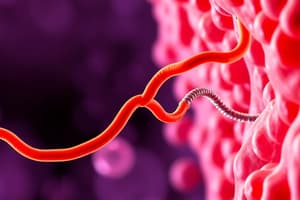Podcast
Questions and Answers
What is the primary function of phosphofructokinase-1 in glycolysis?
What is the primary function of phosphofructokinase-1 in glycolysis?
- To convert pyruvate into lactate
- To inhibit the entry of glucose into the glycolytic pathway
- To phosphorylate glucose to glucose-6-phosphate
- To regulate the rate-limiting step of glycolysis (correct)
What is the effect of ATP on phosphofructokinase-1?
What is the effect of ATP on phosphofructokinase-1?
- It has no effect on phosphofructokinase-1
- It activates phosphofructokinase-1
- It inhibits phosphofructokinase-1 (correct)
- It increases the activity of phosphofructokinase-2
What is the role of hexokinase in glycolysis?
What is the role of hexokinase in glycolysis?
- To phosphorylate glucose to glucose-6-phosphate (correct)
- To convert fructose-6-phosphate to fructose-1,6-bisphosphate
- To regulate the entry of pyruvate into the citric acid cycle
- To catalyze the conversion of lactate to pyruvate
What is the purpose of lactate fermentation during intense exercise?
What is the purpose of lactate fermentation during intense exercise?
What is the result of lactate accumulation in the bloodstream during exercise?
What is the result of lactate accumulation in the bloodstream during exercise?
What is the role of fructose-2,6-bisphosphate in glycolysis regulation?
What is the role of fructose-2,6-bisphosphate in glycolysis regulation?
What is the primary energy system used during low to moderate-intensity activities that last for an extended period?
What is the primary energy system used during low to moderate-intensity activities that last for an extended period?
What is the byproduct of glycolysis that enters the mitochondria for further oxidation?
What is the byproduct of glycolysis that enters the mitochondria for further oxidation?
What is the process by which carbohydrates are broken down to produce energy in the form of ATP?
What is the process by which carbohydrates are broken down to produce energy in the form of ATP?
What is the primary location where the oxidative aerobic system takes place?
What is the primary location where the oxidative aerobic system takes place?
What is the term for the breakdown of carbohydrates, fats, and proteins in the presence of oxygen?
What is the term for the breakdown of carbohydrates, fats, and proteins in the presence of oxygen?
What is the energy system that is highly efficient in producing ATP but requires a constant supply of oxygen?
What is the energy system that is highly efficient in producing ATP but requires a constant supply of oxygen?
Flashcards are hidden until you start studying
Study Notes
Glycolysis Regulation
- Phosphofructokinase-1 (PFK-1) is a key regulatory enzyme in glycolysis.
- PFK-1 is activated by AMP and fructose-2,6-bisphosphate, and inhibited by ATP and citrate.
- PFK-1 controls the rate-limiting step of glycolysis, converting fructose-6-phosphate to fructose-1,6-bisphosphate.
Hexokinase Regulation
- Hexokinase catalyzes the first step of glycolysis, phosphorylating glucose to glucose-6-phosphate.
- Hexokinase is inhibited by glucose-6-phosphate, regulating the entry of glucose into the glycolytic pathway.
Lactate Production and Accumulation
- During intense exercise, pyruvate is converted into lactate through lactate fermentation.
- Lactate fermentation helps regenerate NAD+ for continued glycolysis and energy production.
- Lactate is a valuable energy source for muscles and other tissues.
- Accumulation of lactate in the bloodstream leads to increased blood lactate levels, an indicator of metabolic stress during exercise.
Oxidative Aerobic System
- The oxidative aerobic system, also known as aerobic metabolism or oxidative phosphorylation, produces energy through the breakdown of carbohydrates, fats, and proteins in the presence of oxygen.
- This process occurs mainly in the mitochondria during low to moderate-intensity activities.
- Pyruvate generated from glycolysis undergoes further breakdown in the mitochondria through the Krebs cycle and electron transport chain to produce ATP.
Glucose and Glycogen Oxidation
-
Glucose oxidation involves the breakdown of glucose molecules to produce ATP through glycolysis and oxidative phosphorylation.
-
Glucose is converted into pyruvate in the cytoplasm, producing a small amount of ATP and NADH.
-
If oxygen is available, pyruvate enters the mitochondria for further oxidation, generating a large amount of ATP through oxidative phosphorylation.
-
Glycogen is a storage form of glucose found in the liver and muscles.
-
Glycogenolysis is the process by which glycogen is broken down into glucose molecules to supply energy during periods of high energy demand.
-
Glucose molecules released from glycogen undergo the same metabolic pathways as exogenous glucose, ultimately producing ATP.
Studying That Suits You
Use AI to generate personalized quizzes and flashcards to suit your learning preferences.




